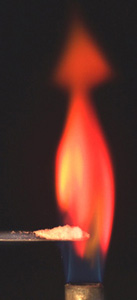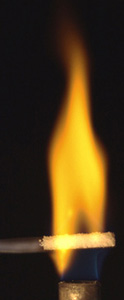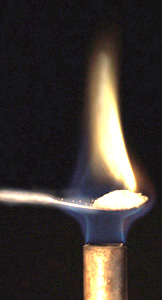Flame Tests
|
|
Now that you have quantitatively measured the emission spectra
for various atoms, you will have the chance to qualitatively
observe the emissions of several excited metal ions.
|
|
To view the emission spectra of metal ions, energy must be
applied to excite the electrons into higher energy levels.
Just as electricity was applied to the discharge tubes, heat
must be applied to a small amount of each metal chloride salt.
You will put a spatula filled with each metal salt into a
burner flame and observe the emission with your eyes.
|
|
Proceed to the flame test stations. At each station, there
will be a white crystalline metal chloride salt, a burner
and a spatula. Place a small amount of the solid on the spatula
and heat it in the flame of the burner. Observe and record
the color of the flame in your lab notebook.
|
|
Move on to the other flame test stations and repeat the above
procedure until you have viewed all of the salts. Each pair
of students should observe and note the emission color for
Na+, K+, Ba2+, Sr2+ and Ca2+.
|
|
Obtain an unknown metal chloride salt from your TA. Get
a spatula and clean it thoroughly with soap and water and
rinse with tap water. Then rinse it well with deionized water
and dry. Heat the empty spatula in the burner flame to remove
any contaminants.
|
|
Heat your unknown solid in a burner flame as you did for
the known metal chloride salts. Record the color of the flame
from your unknown metal chloride salt and compare it to those
from the known solids to determine which ion is present in
your unknown solid.
|
|
Carefully rinse the spatula after it has cooled with water
until any remaining solid is dissolved and return it to the
community property.
|
|
Here are three examples of flames from different elements:
|
|
  
|
|
|
|
| |